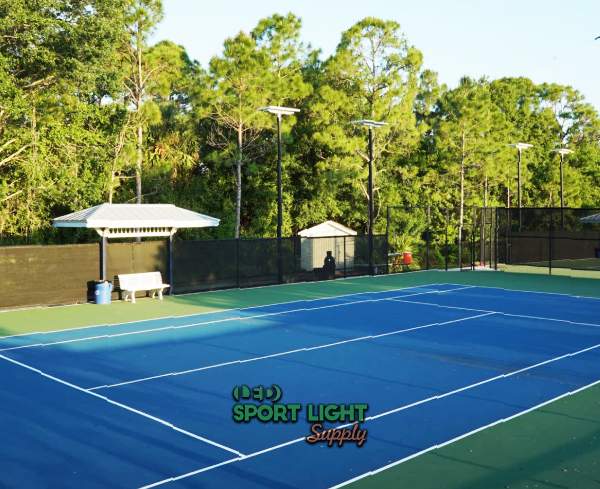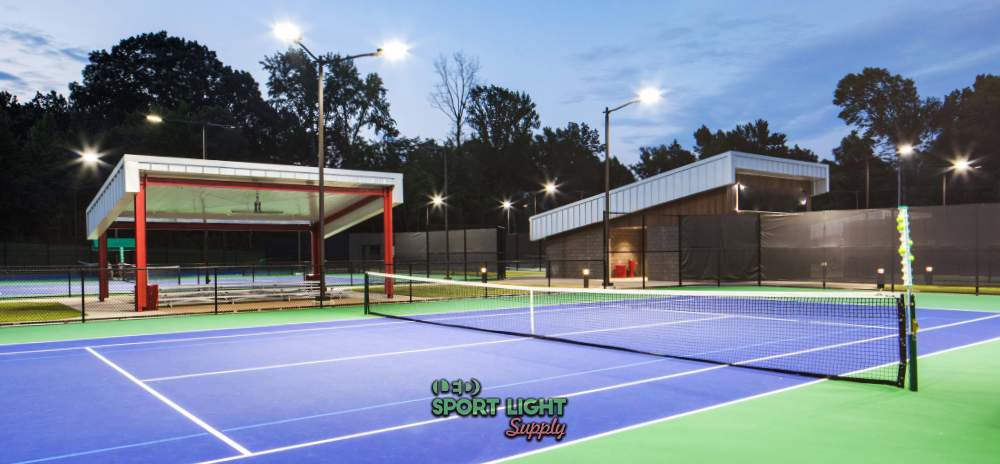
 With the growing emphasis on sustainable energy, sports facilities are increasingly turning to renewable power sources to meet their lighting needs. Solar-powered lighting for tennis courts presents an eco-friendly alternative that reduces costs and environmental impact. This technology harnesses sunlight, making it ideal for facilities looking to improve their sustainability while enhancing the player experience. Solar tennis court lighting has become a popular choice for both public and private venues, offering benefits that extend from energy savings to environmental stewardship and player safety.
With the growing emphasis on sustainable energy, sports facilities are increasingly turning to renewable power sources to meet their lighting needs. Solar-powered lighting for tennis courts presents an eco-friendly alternative that reduces costs and environmental impact. This technology harnesses sunlight, making it ideal for facilities looking to improve their sustainability while enhancing the player experience. Solar tennis court lighting has become a popular choice for both public and private venues, offering benefits that extend from energy savings to environmental stewardship and player safety.
Table of Contents
ToggleSolar tennis court lighting systems operate by using photovoltaic (PV) panels to capture sunlight, converting it into electricity stored in batteries for nighttime illumination. Unlike traditional lighting systems that rely on the grid, solar-powered systems enable facilities to reduce or even eliminate their electricity expenses. This independent power source provides stable energy without the fluctuations in utility costs often experienced with grid-based electricity. Over time, facilities benefit from substantial financial savings, particularly for venues with high nighttime usage.
Because solar-powered systems generate their own electricity, the ongoing expenses related to powering lights are dramatically reduced. Traditional lighting systems involve recurring electricity costs that accumulate rapidly over time, especially for sports facilities that operate well into the night. Solar tennis court lighting avoids these costs, creating a financially sound solution for facilities that wish to keep operational expenses low while maintaining optimal lighting for evening play.
Solar lighting systems help facilities align with global sustainability efforts, as they produce zero greenhouse gas emissions. With climate change and carbon emissions posing significant global challenges, solar energy provides a renewable power source that doesn’t contribute to air pollution or environmental degradation. The absence of emissions from solar-powered lights makes them an attractive option for facilities aiming to minimize their carbon footprint. By choosing solar lighting, sports complexes and recreational centers contribute positively to environmental health, adding value beyond energy savings.
Solar lighting also reduces reliance on fossil fuels, which are finite and produce harmful byproducts. Solar energy is a renewable, inexhaustible source that captures sunlight to power various systems. By tapping into this resource, facilities contribute to reducing fossil fuel dependency, further promoting a greener infrastructure. Solar tennis court lighting aligns with efforts to shift away from traditional energy sources, leading to a cleaner, more sustainable approach to facility management.

Modern solar lighting systems benefit from significant advancements in PV technology, which have made solar panels more efficient at converting sunlight into usable energy. Even in areas with limited sunlight or frequent overcast weather, high-efficiency panels capture and store energy effectively. This adaptability ensures that tennis courts remain well-lit regardless of seasonal changes or variations in sunlight. The progress in solar panel technology allows for greater consistency and reliability in solar-powered lighting, ensuring steady performance year-round.
In addition to improvements in solar panels, advances in battery technology have made it possible to store excess energy generated during the day. High-capacity batteries retain this energy for nighttime use, providing reliable lighting even on days with limited sun exposure. This feature allows facilities to avoid interruptions, as stored energy ensures continuous lighting even during inclement weather or prolonged cloudy periods. These advancements in battery storage also extend the life of solar lighting systems by maintaining consistent performance without over-reliance on sunlight availability.
LED lighting fixtures have become a common choice for solar tennis court lighting systems due to their longevity and energy efficiency. LEDs consume less power compared to traditional bulbs while providing bright, focused illumination that enhances visibility. This lighting quality is especially beneficial for tennis courts, where players require clear visibility to track the ball and move safely around the court. The durability and performance of LEDs, combined with solar power, offer an optimal lighting solution that meets the needs of evening play without sacrificing brightness or efficiency.
The effectiveness of solar tennis court lighting depends heavily on proper installation, particularly in positioning the PV panels. Panels should be installed at angles that maximize sunlight exposure throughout the day, with careful attention to avoiding shaded areas. Any obstruction, whether from buildings, trees, or other structures, can limit the amount of sunlight absorbed, affecting the overall efficiency of the lighting system. Proper installation ensures that panels capture the highest possible amount of sunlight, translating into consistent lighting performance.
While solar lighting systems require less maintenance than traditional systems, periodic checks and cleaning are necessary to maintain optimal performance. Dust, dirt, and debris can accumulate on the panels over time, blocking sunlight and reducing energy capture. Regular cleaning is a straightforward process that helps to preserve efficiency. Additionally, routine inspections of batteries and fixtures allow facilities to address minor issues before they become larger problems, ensuring uninterrupted lighting for players and maintaining the long-term health of the system.
Although the upfront cost of solar lighting may be higher than traditional lighting systems, the long-term financial benefits are substantial. By reducing electricity expenses and minimizing maintenance costs, solar tennis court lighting creates opportunities for significant savings over time. Facilities that invest in solar lighting can anticipate lower operational costs year after year, making it a wise financial choice for organizations looking to cut down on overhead while maintaining high-quality amenities.
Many regions offer financial incentives to encourage the adoption of solar energy solutions. These can include tax rebates, grants, and other forms of assistance to offset installation costs. By taking advantage of these incentives, facility managers can reduce the initial investment required for solar lighting, making it a more affordable option. Government support for renewable energy solutions adds an attractive dimension to solar lighting projects, allowing sports facilities to leverage financial aid as they transition to sustainable energy sources.
Solar-powered systems can be designed to deliver even, uniform lighting that eliminates shadows and dark areas on the court. This uniformity is crucial for players’ visibility, as it allows them to track the ball and move with confidence. Good lighting is essential for high-quality gameplay, as it enables players to react quickly and minimizes any visual obstructions. Solar lighting systems offer this consistency, providing players with well-lit courts that support optimal performance.
Advanced solar lighting systems often include smart features such as motion sensors and programmable timers that enhance the efficiency and functionality of the lights. Motion sensors detect activity on the court and adjust lighting intensity based on player movement, ensuring that the lighting matches the activity level. When the court is not in use, lights can dim or switch off to conserve energy. Programmable timers allow facility managers to set specific lighting schedules, preventing unnecessary power usage. These features contribute to an enhanced player experience while conserving energy, making solar lighting systems both adaptable and efficient.
Sports facilities that incorporate solar lighting demonstrate a commitment to sustainable practices, an attribute that appeals to players, visitors, and the community. As awareness of environmental issues grows, consumers and facility users increasingly prefer venues that actively support eco-friendly practices. Solar tennis court lighting reflects an institution’s dedication to reducing its ecological footprint, boosting its reputation as a forward-thinking organization that prioritizes environmental health.
Sustainability is a growing concern for many individuals, and facilities with green practices are more likely to attract eco-conscious visitors. By implementing solar tennis court lighting, facilities can draw players and patrons who value renewable energy and environmentally responsible choices. Solar-powered amenities become an attractive feature that sets a facility apart, appealing to a demographic that is conscious of the environmental impact of their recreational choices.
Solar tennis court lighting offers a transformative solution that combines cost savings, environmental responsibility, and enhanced player experience. With advances in solar and LED technology, these systems deliver reliable and efficient lighting for nighttime play. By reducing dependence on traditional energy sources and embracing renewable energy, facilities can achieve long-term financial and environmental benefits. Solar lighting represents a step forward in sustainable sports facility management, providing high-quality lighting while minimizing ecological impact and contributing to a greener future. Through financial savings, environmental gains, and a positive impact on player experience, solar tennis court lighting emerges as a practical and sustainable choice for modern sports facilities.
Drop us a line to receive a free lighting design